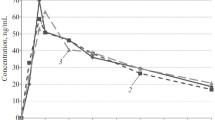Summary
Oral administration of a single 500 mg dose of guancydine rapidly (30 mins) produces a marked fall in systolic and diastolic blood pressure, which lasts for at least 6 h, and is accompanied by tachycardia. Hypotension and tachycardia are more marked on standing, but conspicuous postural falls seldom occur. The decrease in blood pressure does not depend on angiotensin antagonism by guancydine, as pressor responses to angiotensin, as well as to noradrenaline, are not diminished by the drug. Marked fluid and electrolyte retention also occurs after guancydine administration, and is probably due to a reduction in glomerular filtration rate and increased tubular reabsorption of sodium. The time course of the various effects of guancydine closely parallels changes in the plasma concentration of the drug. A very precise quantitative relationship exists between the hypotensive effect and the log of plasma guancydine concentrations between 1 and 5 µg/ml.
Similar content being viewed by others
References
Bartorelli, C., Gargano, N., Leonetti, G., Zanchetti, A.: Hypotensive and renal effects of diazoxide, a sodium retaining benzothiadiazine compound. Circulation27, 895–903 (1963).
Cummings, J.R., Grace, J.L., Jr.: Loss of guancydine's angiotensin inhibitory action in nephrectomized rats and reestablishment of blockade by cross circulation. Pharmacologist11, 270 (1969).
—— Welter, A.N., Grace, J.L., Jr., Gray, W. D.: Angiotensin blocking actions of guancydine. J. Pharmacol. exp. Ther.170, 334–346 (1969).
—— —— —— Lipchuck, L.M.: Cardiovascular actions of guancydine in normotensive and hypertensive animals. J. Pharmacol. exp. Ther.161, 88–97 (1968).
Freis, E.D., Hammer, J.: Guancydine, a new type of antihypertensive agent. Med. Ann. D.C.38, 69–72 (1969).
Gussin, R.Z., Stokey, E.H., Ronsberg, M.A., Malone, L.C.: Mechanisms of antihypertensive-induced fluid retention. Clin. Res.18, 500 (1970).
Leonetti, G., Grazi, S., Ligresti, A., Romano, S., Zanchetti, A.: Autonomic and renal effects of intravenous diazoxide. A study of the mechanisms of its hypertensive action in man. Europ. J. clin. Pharmacol.2, 206–215 (1970).
-- Porro, T., Zanchetti, A.: Hypotensive and renal effects of repeated administration of a new antihypertensive agent, guancydine. In preparation.
Onesti, G., Schwartz, A.B., Kim, K.E., Swartz, C., Brest, A.N.: Pharmacodynamic effects of a new antihypertensive drug, Catapres (ST-155). Circulation39, 219–228 (1969).
Snedecor, G.W., Cochran, W.G.: Statistical methods. Sixth Edition. Ames (Iowa): The Iowa State University Press 1967.
Stenberg, J., Sannerstedt, R., Werkö, L.: Haemodynamic studies on the antihypertensive effect of guancydine. Europ. J. clin. Pharmacol.3, 63–67 (1971).
Author information
Authors and Affiliations
Rights and permissions
About this article
Cite this article
Leonetti, G., Bonazzi, O., Grazi, S. et al. Cardiovascular and renal effects of acute administration of a new hypotensive compound, guancydine. Eur J Clin Pharmacol 4, 1–9 (1971). https://doi.org/10.1007/BF00568890
Received:
Accepted:
Issue Date:
DOI: https://doi.org/10.1007/BF00568890




